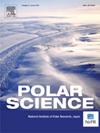Mercury levels in tissues (cartilage, skin, and muscle) of the Greenland shark (Somniosus microcephalus): Potential contamination sources and implications for health and conservation
IF 2
4区 地球科学
Q3 ECOLOGY
引用次数: 0
Abstract
The jaws of the Greenland shark have high levels of mercury. Hg of cartilage in comparison with skin and muscle from the same specimen makes it possible to apprehend the distribution of the pollutant in the body. The level of the pollutant between jaw, skin and fresh meat (muscle) shows a strong correlation. The muscle is the most contaminated element in comparison with the skin and cartilage. The species presents the highest levels among different groups of sharks and the results are in accordance with previous studies. Marine ecosystems in the Arctic are globally contaminated by mercury (atmosphere, water, sediments, food web). The methylmercury reduces blood calcium levels, directly affecting the metabolism of cartilage cells. Even if cases of malformations could not be observed in the Greenland shark, numerous cases for other shark species have been documented in connection with heavy metals (e.g., Hg), and in particular for aplacental viviparous with potential morphological anomalies on embryos. The situation of the Greenland shark is worrying due to the conservation status, the fishing catches, the tardive sexual maturity and reproduction, the climate change and the level of mercury on its organism. The results incite to recommend ecological, environmental and fisheries management measures.
格陵兰鲨(Somniosus microcephalus)组织(软骨、皮肤和肌肉)中的汞含量:潜在污染源及其对健康和保护的影响
格陵兰鲨鱼的下颌中汞含量很高。将软骨的汞含量与同一标本的皮肤和肌肉进行比较,可以了解污染物在体内的分布情况。下颚、皮肤和鲜肉(肌肉)之间的污染物水平表现出很强的相关性。与皮肤和软骨相比,肌肉是受污染最严重的部分。该物种在不同种类的鲨鱼中含量最高,结果与先前的研究一致。北极的海洋生态系统在全球范围内受到汞的污染(大气、水、沉积物、食物网)。甲基汞降低血钙水平,直接影响软骨细胞的代谢。即使在格陵兰鲨中没有观察到畸形的病例,也有许多其他鲨鱼物种的病例与重金属(如汞)有关,特别是胎盘胎生的胚胎可能出现形态异常。由于格陵兰鲨的保护状况、捕捞量、性成熟和繁殖迟缓、气候变化以及其体内的汞含量,格陵兰鲨的状况令人担忧。研究结果有助于提出生态、环境和渔业管理措施。
本文章由计算机程序翻译,如有差异,请以英文原文为准。
求助全文
约1分钟内获得全文
求助全文
来源期刊

Polar Science
ECOLOGY-GEOSCIENCES, MULTIDISCIPLINARY
CiteScore
3.90
自引率
5.60%
发文量
46
期刊介绍:
Polar Science is an international, peer-reviewed quarterly journal. It is dedicated to publishing original research articles for sciences relating to the polar regions of the Earth and other planets. Polar Science aims to cover 15 disciplines which are listed below; they cover most aspects of physical sciences, geosciences and life sciences, together with engineering and social sciences. Articles should attract the interest of broad polar science communities, and not be limited to the interests of those who work under specific research subjects. Polar Science also has an Open Archive whereby published articles are made freely available from ScienceDirect after an embargo period of 24 months from the date of publication.
- Space and upper atmosphere physics
- Atmospheric science/climatology
- Glaciology
- Oceanography/sea ice studies
- Geology/petrology
- Solid earth geophysics/seismology
- Marine Earth science
- Geomorphology/Cenozoic-Quaternary geology
- Meteoritics
- Terrestrial biology
- Marine biology
- Animal ecology
- Environment
- Polar Engineering
- Humanities and social sciences.
 求助内容:
求助内容: 应助结果提醒方式:
应助结果提醒方式:


